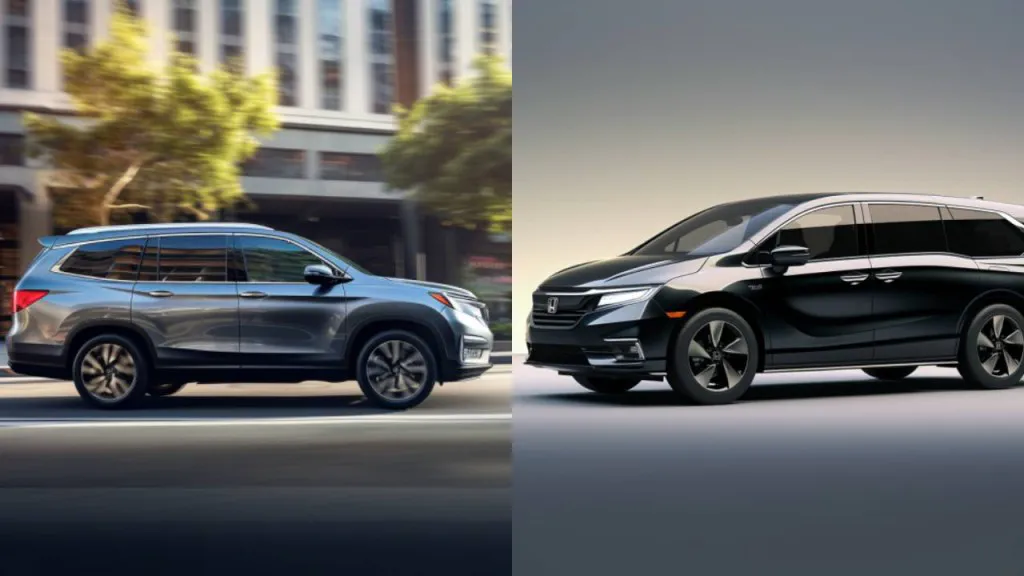The auto market is overflowing with three-row vehicles, cars designed to haul ample cargo and transport more than five or six people. For shoppers focused on the Honda brand, this means choosing between the Pilot SUV and the Odyssey minivan. Some buyers may recoil at the idea of driving a minivan, but these boxes on wheels have their champions. Keep reading, and you’ll learn why as I look at the 2023 editions of the Honda Pilot and the Honda Odyssey.
How can an SUV and a minivan compare? In the case of these Hondas, very closely. Except for the obvious external differences, these vehicles are remarkably similar. This makes sense as the Pilot and Odyssey share a platform, engine, and transmission and are built in the same Alabama factory. There are only so many changes an automaker can make when working with matching basic ingredients. This formula includes the Honda Ridgeline pickup and Acura MDX SUV.
For over 25 years, I’ve always had at least one Honda product in the driveway. I bought these cars because they’re competent and comfortable—the same qualities that help sell the Pilot and Odyssey. No one buys Honda SUVs and minivans to turn heads, but because they’ve prioritized the practical. If you have kids, you know what I mean.
2023 marks the launch of the fourth-generation Pilot. Its sharp body panels and bold-for-Honda front end sync with the looks of the all-new CR-V (which also debuted for 2023). Suddenly, Honda has consistent looks for its SUVs (excluding the HR-V). The company reworked the engine to squeeze out five extra horsepower and added handling refinements to the Pilot.
If ever a car in Honda’s lineup was guilty of being dubbed an “appliance,” it’s the 2023 Odyssey. Short of a mild refresh in 2021, this minivan is visually unchanged from 2018, the first year of the fifth generation. Honda has less incentive to update the Odyssey; it sold less than 50,000 in 2022 (compared to almost 100,000 Pilots).
The 2023 Pilot has several advantages over its stablemate. It’s not a minivan (stigmas die hard) and is available with all-wheel drive. Plus, those who prefer to drive a car with the newest styling will appreciate the Pilot’s new looks.
However, don’t sell the 2023 Odyssey short; it also has strong points. Chiefly, this minivan is HUGE inside, especially in the third row. Flip down the back seats, and the Odyssey shames the Pilot’s cargo capacity.
You’ll want to see what else separates and aligns the 2023 Pilot and Odyssey. I’ve broken down prices, powertrain specs, ownership costs, safety rankings, key equipment, and warranty details. It’s all spelled out ahead.
Curious about how older Pilot and Odyssey models stack up? Read: Honda Pilot vs. Honda Odyssey | The Best Model Year For Every Budget.
Learn more about the methodology used for this article.
2023 Honda Pilot Vs. Honda Odyssey | A Guide to Trim Levels & Optional Features
Trim Levels: Starting Prices
Quick Take: The cheapest offering comes as a base Pilot, but you’ll spend less for an Odyssey when comparing higher trims.
Honda takes different starting price approaches for the Pilot and Odyssey. The automaker offers a more basic entry-level Pilot, the LX, with a $36,300 MSRP. In contrast, the base Odyssey begins at the EX trim level and has a $37,840 MSRP. Honda knows the competition is fierce in the three-row midsize crossover market, so it offers an option for price-sensitive shoppers.
On the other hand, the pickings are slim for new minivan buyers. The Odyssey has only three direct competitors: the Toyota Sienna, Chrysler Pacifica, and Kia Carnival. As a result, Honda pushes shoppers upscale by making the EX the starting trim for the Odyssey.
Pricing flips at the more premium offerings. Want leather upholstery, a power tailgate, and other goodies with your three-row Honda? You’ll need to step up to the EX-L. As a Pilot, this trim runs $42,300. Yet, these features cost $1,382 less with the Odyssey EX-L (with a $40,918 starting price). It’s worth mentioning that the trim levels don’t quite match between these two Hondas. For example, the Odyssey EX-L has a power moonroof, but the Pilot EX-L doesn’t.
Moving toward top-tier editions continues the Odyssey’s price advantage. The Pilot Touring sells for $46,800, while the Odyssey Touring goes for $45,100, a $1,700 difference. The ultimate Elite trim includes high-end equipment like heated and ventilated front seats and more infotainment features. These versions have the greatest price gap: $2,410. A Pilot Elite goes for $52,380, compared to $49,970 for the equivalent Odyssey.
The $48,700 Pilot TrailSport is unique, thanks to more off-road-oriented gear, such as an upgraded all-wheel-drive system and all-terrain tires. There is nothing like this in the Odyssey lineup.
| 2023 Honda Pilot Model | Starting Price |
| LX | $36,300 |
| Sport | $39,500 |
| EX-L | $42,300 |
| TrailSport | $48,700 |
| Touring | $46,800 |
| Elite | $52,380 |
| 2023 Honda Odyssey Model | Starting Price |
| EX | $37,840 |
| EX-L | $40,918 |
| Sport | $41,860 |
| Touring | $45,100 |
| Elite | $49,970 |
Cost of Ownership
Quick Take: The Odyssey is slightly less expensive to own.
Sometimes, deciding between two cars comes down to price. Smart shoppers look beyond MSRP and also consider long-term ownership costs. Edmunds uses a standardized formula (based on driving 15,000 miles per year) to assess the hit to the wallet over five years.
Looking at the entry-level trim for each edition (including a Pilot with front-wheel drive, like the Odyssey) reveals strikingly similar numbers. Over half a decade, the Pilot costs owners $55,048 or $0.73 per mile versus $54,355 or $0.72 per mile for the Odyssey. The Odyssey remains cheaper, but not by much, about $138 per year.
This close contest comes from near-identical depreciation and the same fuel expenses. Even with the Pilot’s lower starting price, the Odyssey’s cheaper repair bill helps give this minivan a minor edge over the Pilot.
| 5-Year Ownership Cost | ||
| Costs | Honda Pilot | Honda Odyssey |
| Trim | LX (FWD) | EX |
| Cost to Own | $55,048 | $54,355 |
| Average Cost Per Mile | $0.73 | $0.72 |
| Depreciation | $17,868 | $17,852 |
| Fuel | $11,695 | $11,695 |
| Maintenance | $5,127 | $3,471 |
| Repairs | $631 | $637 |
2023 | Honda Pilot Vs. Honda Odyssey | Specifications | Safety, Interior, and Exterior Features
Sizing up the Honda Pilot and Honda Odyssey involves a look at each vehicle’s specifications. Here’s what you need to know.
Vehicle Class & Body Style:
Quick Take: The Pilot and Odyssey are spacious and have three rows, but this Honda minivan is slightly larger.
Vehicle class determinations are made by the U.S. Environmental Protection Agency (EPA), which kind of restates the obvious. The Pilot is a midsize SUV, while the Odyssey wears a minivan label.
Yet, this apples-to-oranges comparison leads to a couple of significant similarities. Both have cavernous cabins (up to 158.4 cubic feet for the Pilot and as much as 163.6 cubic feet for the Odyssey) and have three-row seating.
Keep reading to see how the interior space affects measurements, such as legroom.
| 2023 Honda Pilot | 2023 Honda Odyssey | |
| Class | Mid-Size SUV | Minivan |
| 4-Door Minivan | LX, Sport, EX-L, TrailSport, Touring, Elite | EX, EX-L, Sport, Touring, Elite |
Powertrain:
Quick Take: A shared engine for the Pilot and Odyssey leads to similar performance and fuel economy. However, a Pilot with AWD can tow more.
Engine Options & Specifications:
There’s basically no difference under the hood of the Pilot and Odyssey. Both models share a 3.5-liter V6, with the Pilot getting a slightly newer version. The J-Series engine is as synonymous with Honda as Big Macs are to McDonald’s. It’s a proven powerplant with origins dating back 40 years. For over 20 years, I’ve had various Honda products with the 3.5-liter V6. My only complaint is having to deal with the occasional timing belt change.
Is this the most powerful non-turbo V6 on the market? Not even close, but these 3.5-liters serve Honda and its customers just fine. 285 horsepower propels an all-wheel-drive-equipped Pilot from zero to 60 mph in a spirited 6.7 seconds (6.9 seconds with front-wheel drive). The 280-horsepower (and slightly lighter) Odyssey does this dash in 6.6 seconds. In my book, quick acceleration begins below 7.0 seconds for a 0-60 mph run.
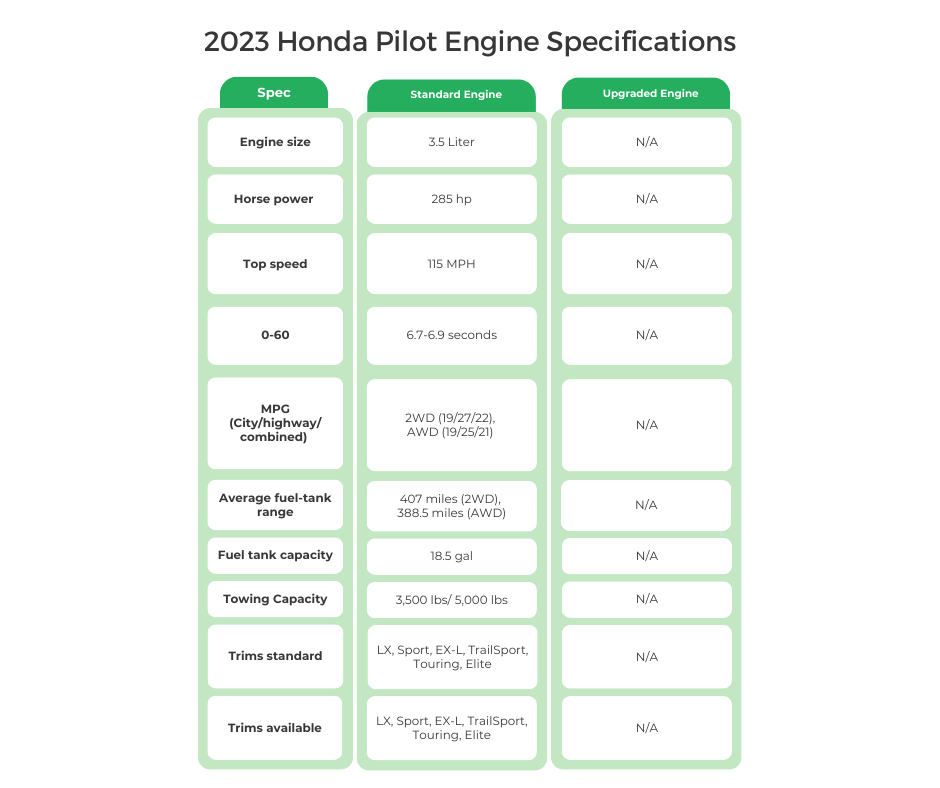
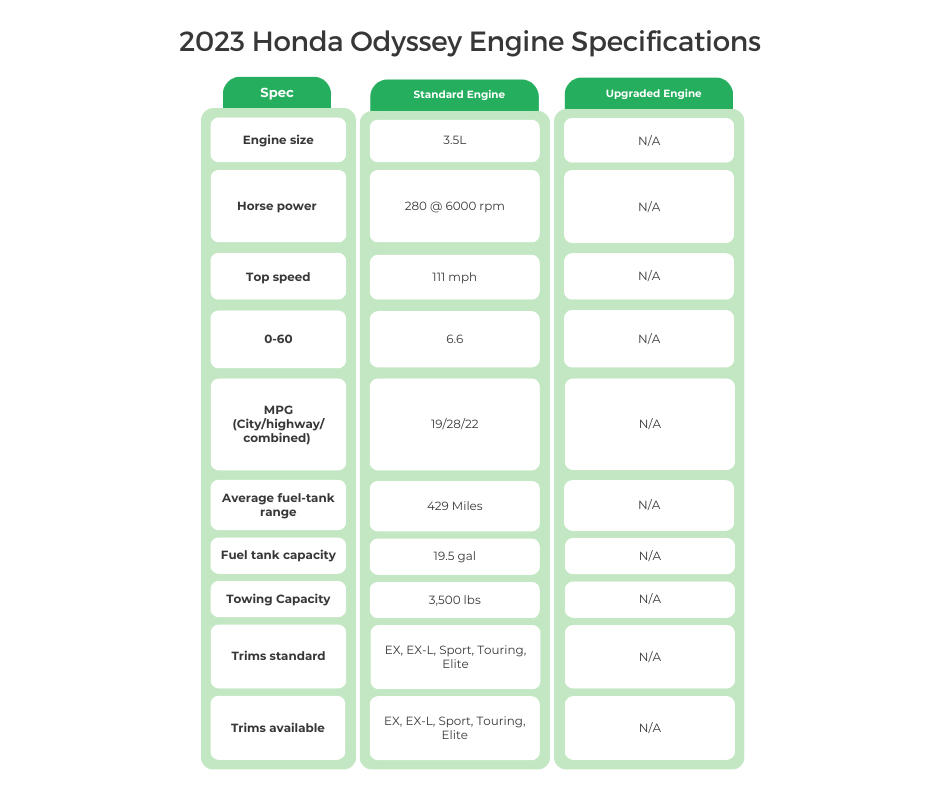
Fuel Economy:
With front-wheel drive (FWD), the Pilot is rated for fuel economy almost identical to the Odyssey’s. The Environmental Protection Agency (EPA) estimates 19 mpg in the city and 27 mpg on the highway for the Pilot. The Odyssey ekes out an extra mile-per-gallon (28 mpg). Meanwhile, highway fuel economy drops to 25 mpg for a Pilot with all-wheel drive (AWD).
Gas mileage won’t be a factor if you’re looking for a reason to help choose between a Pilot and an Odyssey.
Wondering about fuel economy for an older Pilot or Odyssey? Check out: Honda Pilot Vs. Honda Odyssey | The Best Model Year For Every Budget.
Towing:
One consideration that might impact a purchase decision is towing capacity. The Odyssey and a Pilot with FWD are rated for 3,500 pounds. Add AWD to Pilot, and you have a vehicle that can pull 5,000 pounds. The extra capacity could matter if you tow a boat or travel trailer.
Transmission Options & Specifications:
While Honda is a fan of continuously variable transmissions (see the “Tech Talk” section below the charts to learn about CVTs), the company sticks with a conventional gearbox for the Pilot and Odyssey. Both vehicles get a sophisticated ten-speed automatic that offers a nice blend of performance and efficiency.
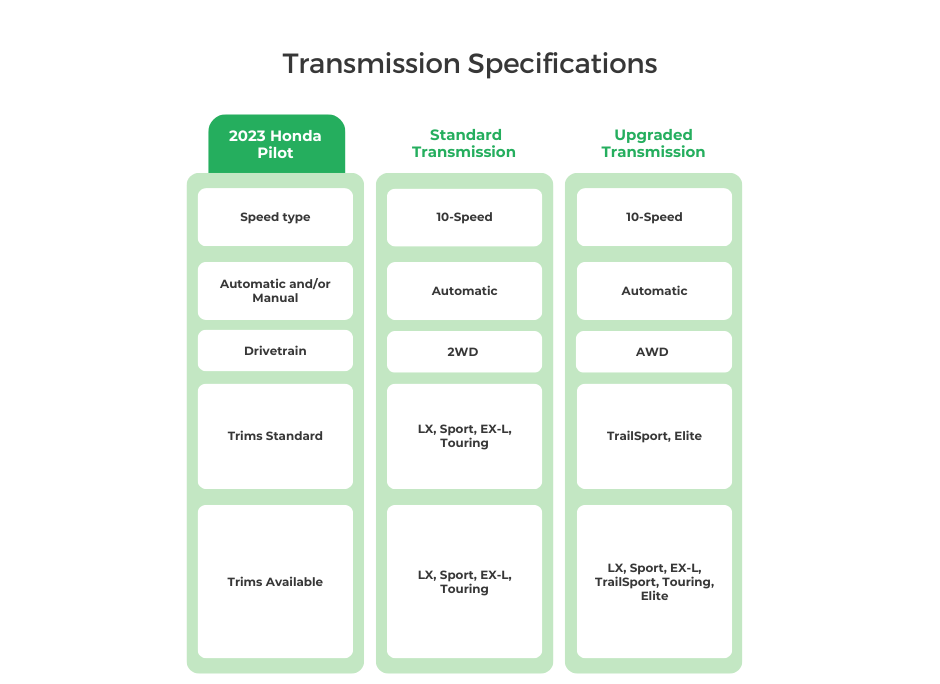
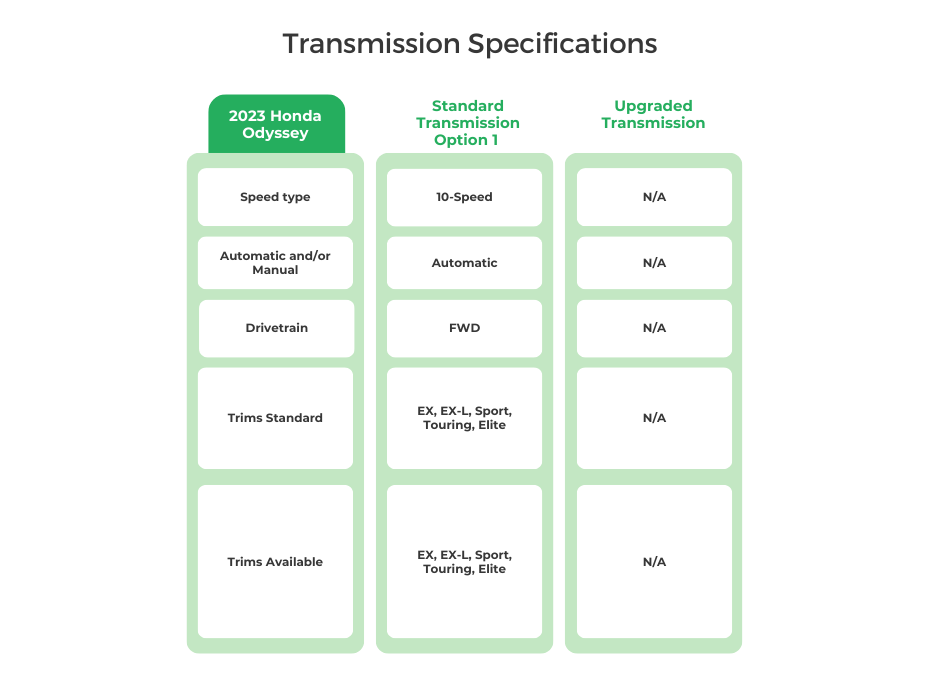
TECH TALK: CVTs
A continuously variable transmission (CVT) does not use gears like a typical automatic transmission. Instead, it has two pulleys connected by a belt. One pulley connects to the engine, and the other connects to the wheels. The belt transfers the power between the pulleys. This setup allows the pulleys to continuously change positions as needed. The CVT automatically adjusts the pulleys as required, providing smooth and efficient power delivery.
Drivetrain:
Thanks to a shared platform, front-wheel drive is the sole drivetrain for the Odyssey and the starting point for the Pilot. Honda makes all-wheel-drive optional for the Pilot (it’s standard with the TrailSport trim). If AWD is a must-have for a minivan, you’ll have to shop for a Toyota Sienna or Chrysler Pacifica; the 2023 Odyssey is strictly FWD.
| 2023 Honda Pilot Wheel Drive | FWD | AWD | RWD |
| LX | S | U | |
| Sport | S | U | |
| EX-L | S | U | |
| TrailSport | S | ||
| Touring | S | U | |
| Elite | S |
| 2023 Honda Odyssey Wheel Drive | FWD | AWD | RWD |
| EX | S | ||
| EX-L | S | ||
| Sport | S | ||
| Touring | S | ||
| Elite | S |
Safety:
Quick Take: There’s no NHTSA testing yet for the Pilot, but the Odyssey gets five-star scores. Both vehicles get top marks from IIHS.
NHTSA Safety Ratings
Modern family vehicles like the Pilot and Odyssey generally do well in government crash testing. It’s the minimum price of entry for vehicles tasked with transporting children. The Pilot has a history of very strong safety scores in testing by the National Highway Traffic Safety Administration (NHTSA). However, there’s no official word about how the 2023 Pilot has performed. It’s typical for it to take a year or two before an all-new vehicle goes through the crash testing process.
The current-generation Odyssey has been around since 2018 and has a well-established track record of solid safety scores. The 2023 edition gets perfect five-star ratings for overall crash-test performance and frontal and side evaluations. A four-star rollover rating is normal for tall vehicles with a raised center of gravity.
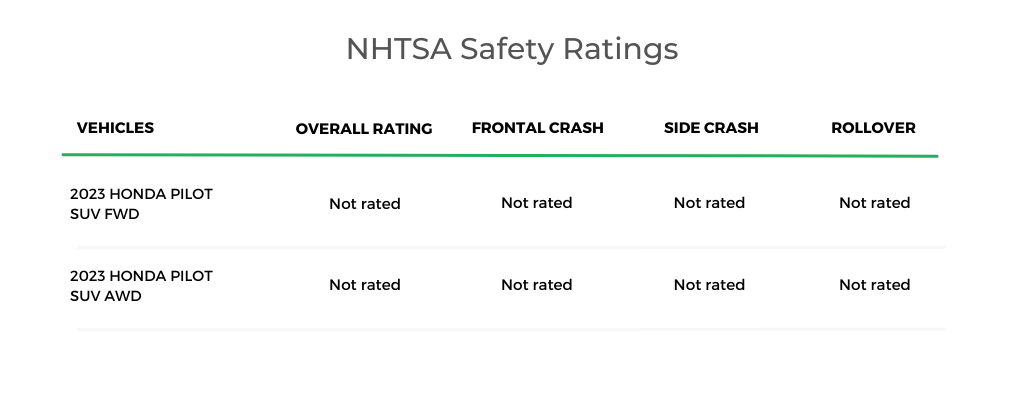

IIHS Awards:
The Insurance Institute for Highway Safety (IIHS) takes a somewhat different approach to safety testing. In particular, it focuses on its small frontal overlap crash test, which the organization feels represents a more real-world scenario (a single car running into a fixed object). IIHS also looks at side impact crashes, roof strength, headlight effectiveness, and advanced driver safety technologies (like automatic emergency braking).
While tested vehicles receive a Good, Acceptable, Marginal, or Poor grade, the true measure comes if a car gets a Top Safety Pick or Top Safety Pick+ designation. If “Good” is a “B” grade, Top Safety Pick notches things up to an “A-,” and the Top Safety Pick+ signifies an “A+.”
Pilot and Odyssey shoppers can be confident that both models receive top honors from IIHS.
| IIHS Award | Tested Vehicle | ||
| 2023 Honda Pilot | Midsize SUV/4-Door SUV | 2023 TOP SAFETY PICK + | 2023 Honda Pilot Elite 4-door AWD |
| 2023 Honda Odyssey | MINIVAN | 2023 TOP SAFETY PICK + | 2018 Honda Odyssey LX, EX-L, and Touring |
| 2021 Honda Odyssey Elite | |||
Airbags & Head Restraints:
Vehicle safety also means protecting passengers with multiple airbags. The Pilot and Odyssey share the same system, providing front-row airbags and side units that protect all three rows during an accident or rollover. Front-row knee airbags also help position the body to minimize injury during a front-end collision.
Neither the Pilot nor the Odyssey comes with overhead airbags. This newer technology replaces traditional front-row units (steering wheel and dashboard) with overhead devices. Active head restraints are usually found in specialty and high-end vehicles to minimize whiplash injuries. Mainstream cars like the Pilot and Odyssey aren’t usually equipped with this feature.
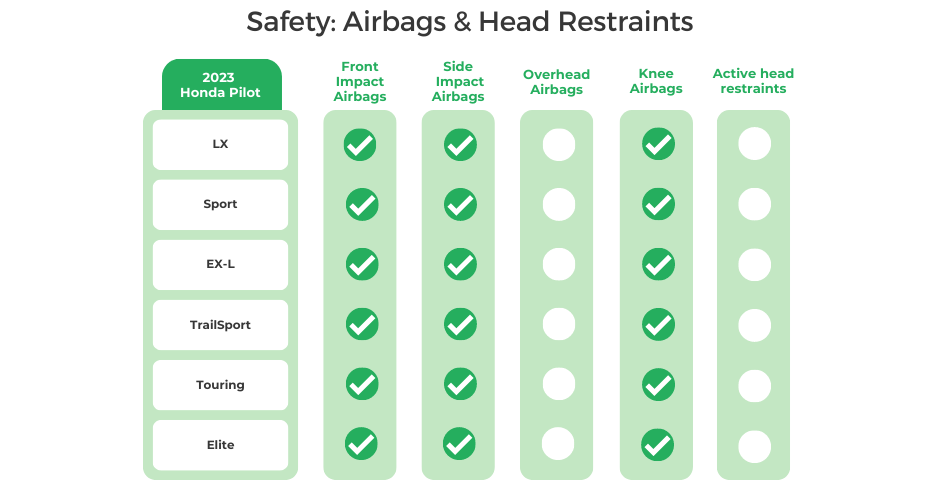
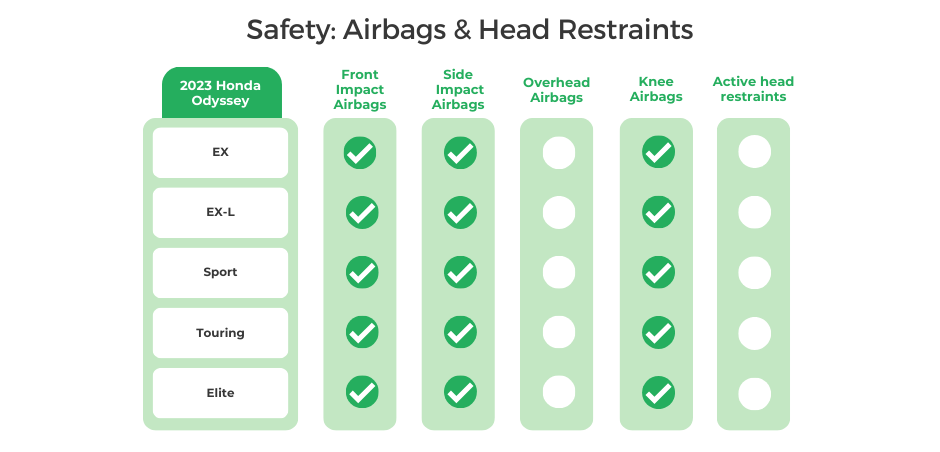
Driver-Focused Features and Equipment:
Quick Take: The Pilot and Odyssey have the same driver-assist features, but the base Pilot lacks essential tech.
Semi-Autonomous Driving:
Cutting-edge technology, like the hands-free driving system in a Tesla, is not Honda’s forte. Instead, the company is all about using equipment that’s proven not a gimmick or unreliable. So, the Pilot and Odyssey get semi-autonomous driving features, such as adaptive cruise control (ACC). ACC automatically adjusts a vehicle’s speed to maintain a safe distance from cars in front.
The Pilot and Odyssey also support drivers with lane-keeping systems that provide subtle steering adjustments to maintain a car’s correct position. All trims of both vehicles have this equipment.

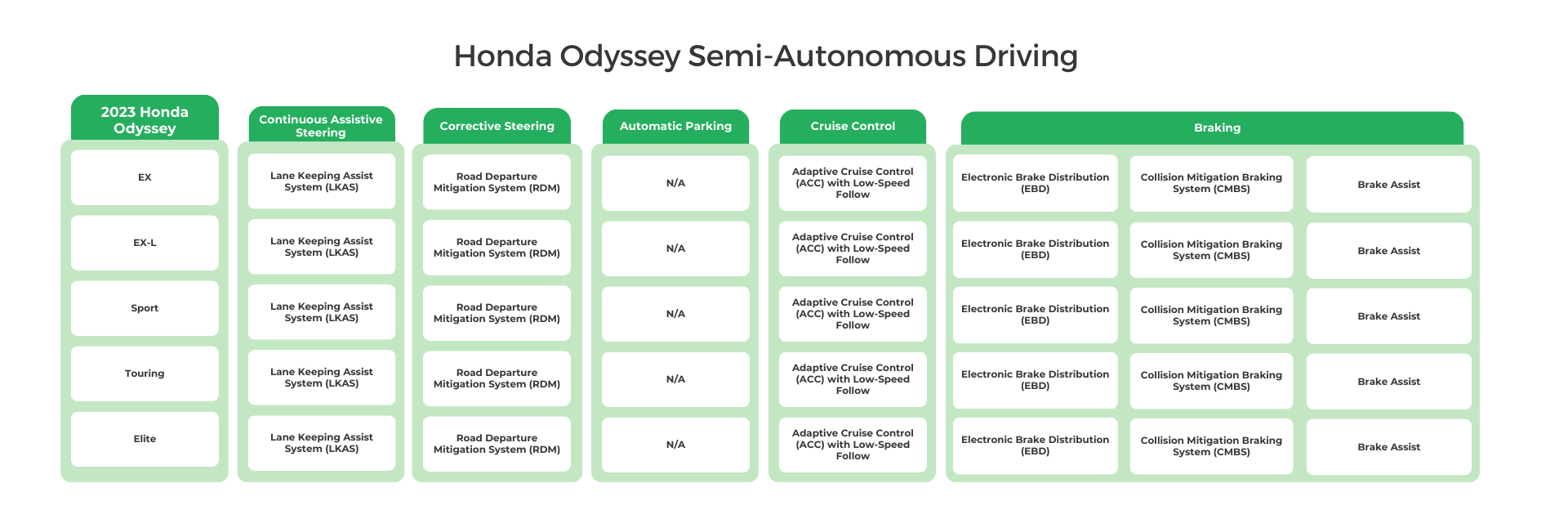
Driver Warning Systems & Telematics:
Advanced driver assistance systems (ADAS) are standard equipment in just about every new car. Most 2023 vehicles, including the Pilot and Odyssey, are equipped with forward collision warning (FCW), automatic emergency braking (AEB), and other driver-assist technologies.
However, Honda is notorious for not including other fundamental features, such as blind-spot monitoring (BSM) and rear cross-traffic alert (RCTA), in its lower-priced models (or charging for an upgrade). Such is the case with the Pilot LX. Otherwise, all other Pilot and Odyssey versions get this technology. Regardless of trim, both vehicles also get a rear-seat reminder and driver attention monitor.
If ADAS technology appears like alphabet soup, check out an effort from AAA, Consumer Reports, J.D. Power, and other groups working to standardize the terminology for these systems.


Road Visibility Features:
It wasn’t too long ago that LED headlights were reserved for high-end vehicles, but premium features eventually make their way to mainstream vehicles like the Pilot and Odyssey. LED headlights offer brighter, more natural-looking light, lower energy consumption, and a longer lifespan than traditional headlights. Automatic high beams are convenient for drivers and safety equipment for oncoming traffic. It’s another item found on these Hondas.
Justification for the higher prices of the Elite trim comes from extra like rain-sensing windshield wipers. The Pilot Elite goes one step further with a head-up display for projecting important driving information like speed and navigation details on the windshield.
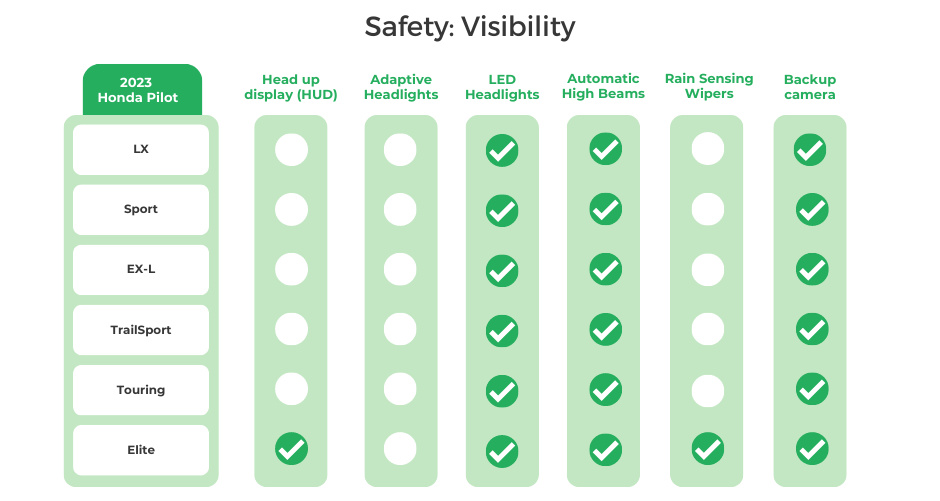
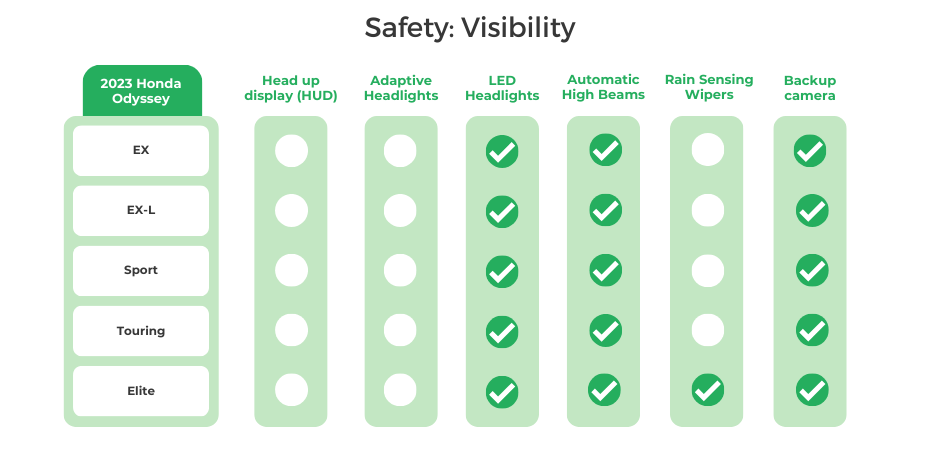
Interior:
Quick Take: Smartphone connectivity is no problem for most Pilots and all Odysseys. The Odyssey dominates the Pilot in third-row legroom and cargo space.
Interior Features:
The expression “you get what you pay for becomes evident when looking at the interior features of the Pilot—specifically, heated front seats. If you want them, you’ll need to cough up the extra to buy the Sport or higher trim. Because the Odyssey lineup starts higher (with the EX trim), all 2023 Honda minivans have heated front seats.
At least, the automaker includes Apple CarPlay and Android Auto with all 2023 Pilots and Odysseys, regardless of trim. The ability to connect a cell phone to a car’s infotainment system is a minimum expectation for many car buyers.
And speaking of heated seats, some automakers offer this feature through a subscription service. This hasn’t yet happened in the U.S., but in certain countries, BMW offered heated seats for a monthly fee. The advantage is you can shut off the service during warm months, but you’ll need to keep paying (or pay a one-time upfront fee) to activate the heated seats. Recently, BMW announced it was backing away from this practice. Moving forward, the automaker will only charge a subscription for software-based services (like upgraded navigation). Hardware-based features will be part of the vehicle’s initial purchase price.
One industry study shows mixed results for consumer acceptance of features on demand (FoD), with about one-fifth not even being aware of the concept.


Interior Dimensions:
Looking at interior dimensions for the Pilot and Odyssey begins with getting a handle on seating capacity. If you never have to worry about transporting more than seven people, either model will meet your needs. However, squeezing an eighth rider requires attention among Pilot shoppers. The TrailSport and some EX-L trims are equipped with second-row captain’s chairs that drop capacity to seven. Yet, there’s no sweat with packing family and friends into the Odysseys; all versions are set up for eight occupants (even if it might be a tight squeeze).
Most primary measurements (such as legroom in the front and second rows) are within an inch of each other. For example, a Pilot with a moonroof has 39.1 inches of front headroom versus 38.7 inches for a moonroof-equipped Odyssey.
But, there are crucial dimensions that give the Odyssey a clear advantage. This Honda minivan has a generous 38.1 inches of third-row legroom, compared to a tight 32.5 inches for the Pilot. This half-foot difference can make for a lot less complaining during a long road trip.
No matter how some may hate on minivans, these vehicles are the undisputed cargo space champion. The Pilot’s 18.6 cubic feet behind the third row falls far short of the 32.8 cubic feet at the back of the Odyssey. With the third row not in use, the Pilot offers 48.5 cubic feet against 89.5 cubic feet in the Odyssey.
The Odyssey especially shines for those who need to prioritize moving stuff over people. Behind the first row, this minivan’s 144.9 cubic feet of cargo space dominates the 87 cubic feet available in the Pilot.
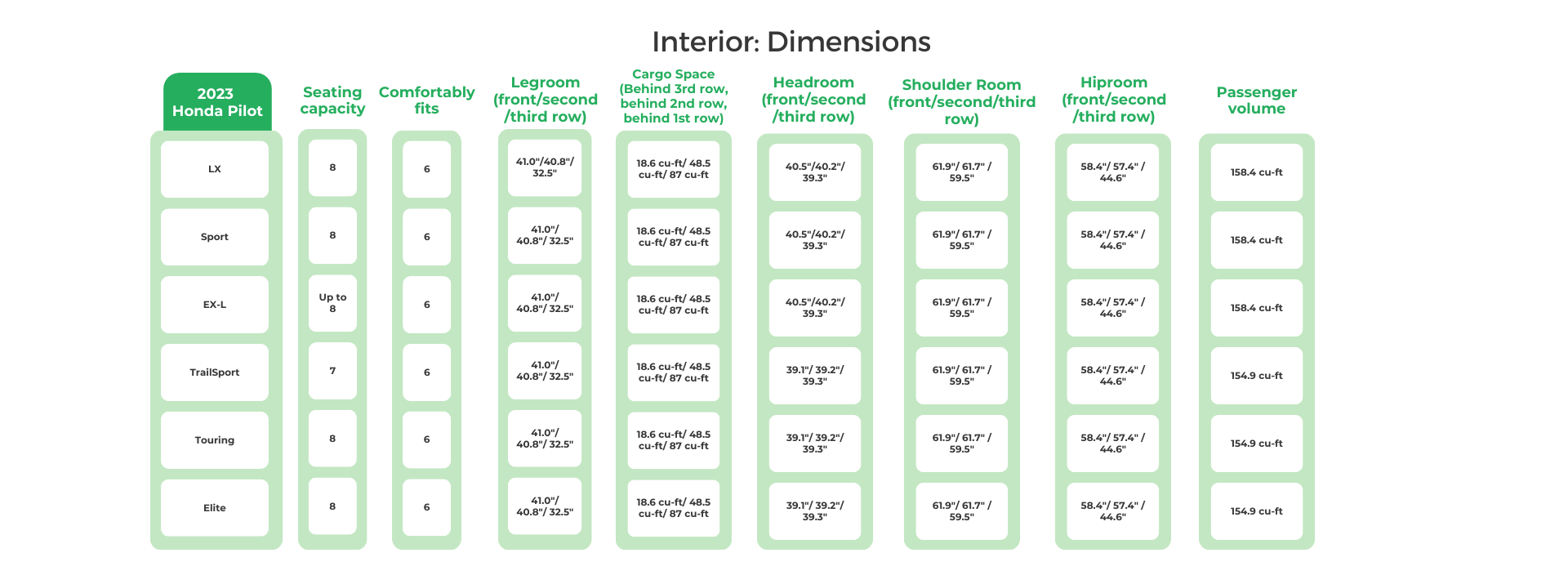

Exterior:
Quick Take: Most colors for the Pilot and Odyssey are muted shades. The more spacious Odyssey is bigger on the outside, too.
Exterior Features:
Wheels may also be an afterthought for many car buyers. But wheel size can impact ride quality. Larger rims can translate into better traction and cornering but may result in a bumpier ride. Bigger wheels also offer better aesthetics by filling out the wheel wells more completely. This is why the higher the trim, the larger the wheel. Different materials (steel or alloy) and finishes also help separate the wheels among the various trim levels.
Don’t look for wild colors on family vehicles like the Pilot and Odyssey. These cars are meant to blend in, not stand out. Radiant Red Metallic (available for both models) is as wild as it gets. That said, the Pilot TrailSport is available in Diffused Sky Blue Pearl, a color I’d describe as a very bold baby blue. Buyers looking for more ordinary colors have a host of white, black, silver, and gray options. Honda also offers a dark blue.
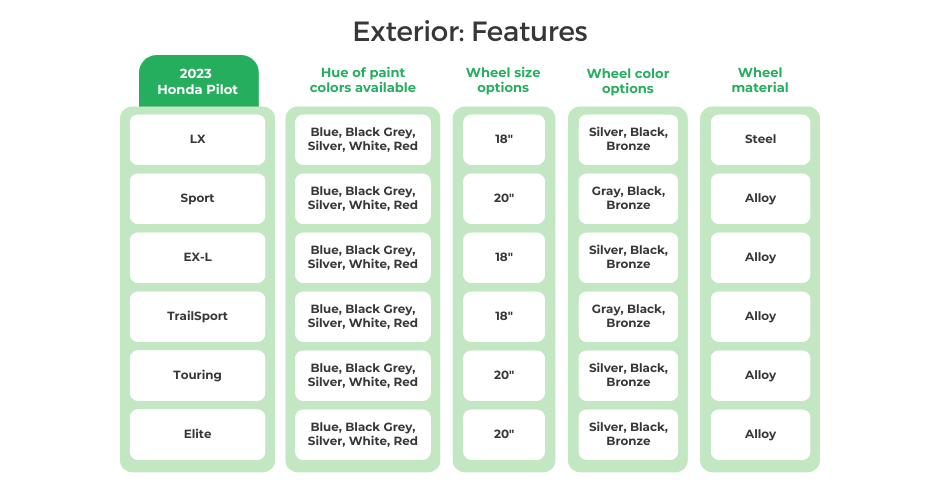
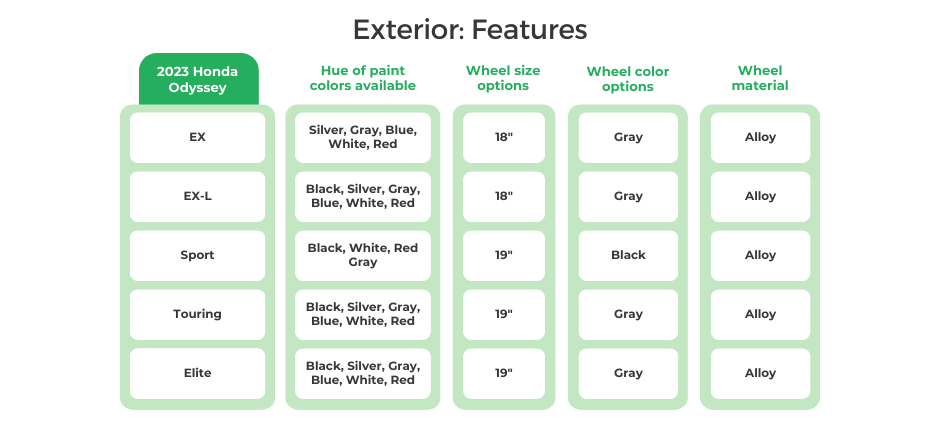
Exterior Dimensions:
The Odyssey’s more accommodating interior comes at a price: an extra 5.3 inches of length. Suburban drivers may not give much thought to this, but anyone who regularly deals with a small garage or tight parking space will. Width-wise, the Pilot and Odyssey are identical.
Buyers will also want to consider ground clearance. The Pilot’s 7.3 inches (add an inch for the TrailSport) is well-suited for its utility duties. However, this height can make it more challenging for children to enter and exit the vehicle. Conversely, 4.5 inches of ground clearance with the Odyssey makes access a breeze. Yet, this reduced clearance space can make the car vulnerable over speed bumps and while traveling unpaved roads.
If ride comfort is a priority, you’ll want to test drive both vehicles. The Odyssey’s longer wheelbase may do a better job smoothing rough road surfaces.
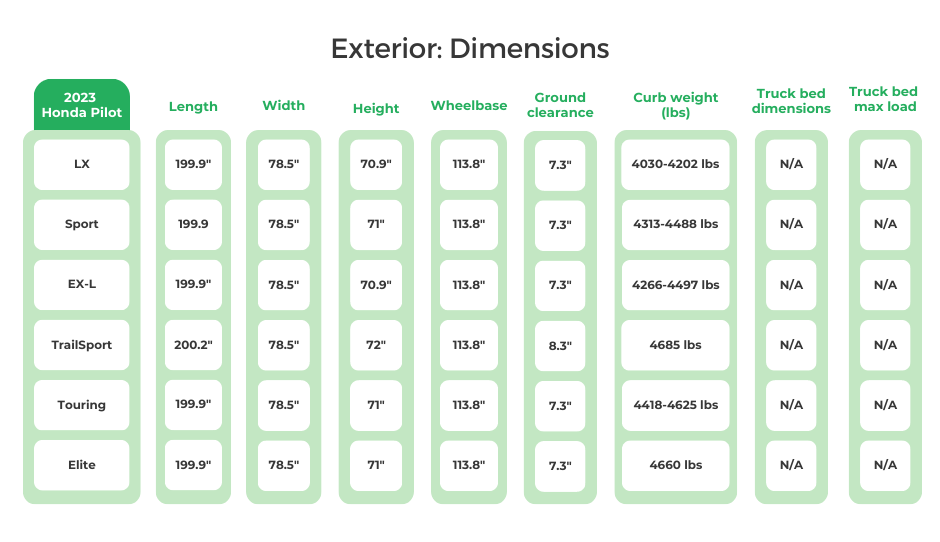
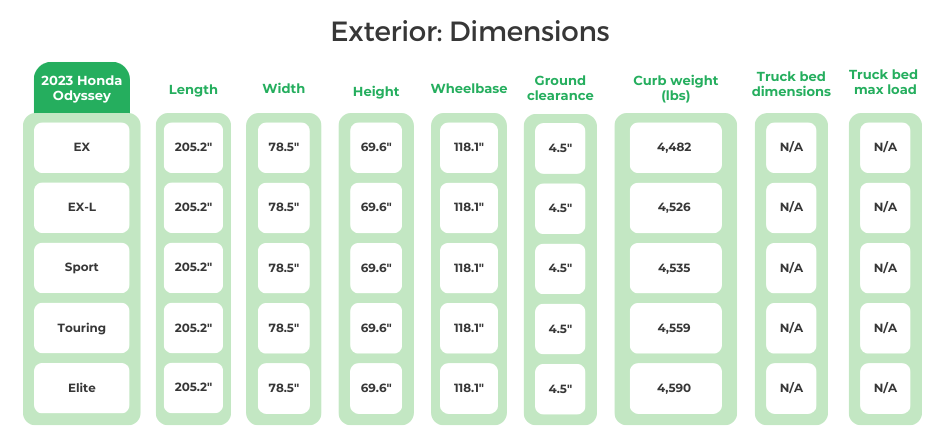
Warranty:
Quick Take: Warranty coverage for the Pilot and Odyssey is identical.
Because the Pilot and Odyssey wear a Honda badge, both vehicles have the same factory warranty. These cars have three years of 36,000 miles of bumper-to-bumper coverage and powertrain safeguards for five years or 60,000 miles.
Honda also includes free scheduled maintenance for two years (or 24,000 miles) and roadside assistance for three years (or 36,000 miles).
| 2023 Honda Pilot Factory Warranty Coverage: | 2023 Honda Odyssey Factory Warranty Coverage: | |
| Basic warranty: | 36 Months/36,000 miles | 36 months/36,000 miles |
| Powertrain warranty: | 60 months/60,000 miles | 60 months/60,000 miles |
| Corrosion perforation warranty: | 60 months/Unlimited miles | 60 months/unlimited miles |
| Air conditioning warranty: | 24 Months/24,000 miles | 24 months/24,000 miles |
| Battery warranty: | 36 Months/36,000 miles | 36 months/36,000 miles |
| Emissions warranty: | Federal: 36 Months/36,000 miles California: 36 Months/50,000 miles | Federal: 36 months/36,000 miles California: 36 months/50,000 miles |
| Roadside assistance coverage: | 36 months/36,000 miles | 36 months/36,000 miles |
| Complimentary scheduled maintenance: | 24 months/25,000 miles | 24 months/24,000 miles |
| Total unique recalls: | 0 | 1 |
Methodology
- Compare two vehicles, Honda Pilot and the Honda Odyssey, and provide a comprehensive analysis.
- Gather relevant information and data on both vehicles from reliable sources, such as manufacturer specifications, expert reviews, customer feedback, industry reports, and data sources like manufacturer websites, FIXD App, Kelley Blue Book, FuelEconomy.gov, and NHTSA.
- Collect data on various aspects, including performance, safety features, fuel efficiency, maintenance costs, reliability, owner satisfaction, and market value.
- Identify the key criteria that will be used to evaluate and compare the two vehicles.
- Ensure the criteria cover both objective factors (such as performance metrics, safety ratings, and fuel efficiency) and subjective factors (such as owner satisfaction, comfort, and features).
- Assess the performance of both vehicles based on factors such as acceleration, handling, braking, and overall driving experience.
- Compare engine options, horsepower, torque, transmission options, and any unique performance features.
- Examine the safety features and ratings of both vehicles.
- Evaluate crash test ratings, advanced driver assistance systems (ADAS), active and passive safety features, and any notable recalls or known issues related to safety.
- Consider both NHTSA safety ratings and IIHS awards for a comprehensive safety assessment.
- Analyze the fuel economy of both vehicles based on EPA mileage estimates.
- Compare their MPG ratings, average full-tank range, and any significant differences in fuel efficiency.
- Assess the average annual maintenance and repair costs for both vehicles.
- Consider data from surveyed owners and other reliable sources, such as FIXD App owner surveys, to determine the overall cost of ownership over time.
- Evaluate the reliability of both vehicles based on owner reports, FIXD App data, and any known issues or recalls.
- Consider factors such as engine reliability, common problems by model year, long-term durability, and owner reliability scores gathered from surveys.
- Consider owner satisfaction by gathering information from forums, online communities (Reddit: r/whatcarshouldIbuy), customer reviews, and owner reliability scores.
- Summarize key factors that owners appreciate and any common complaints or drawbacks mentioned by owners.
- Compare the features and technologies offered by both vehicles.
- Highlight any notable differences in terms of infotainment systems, connectivity options, driver assistance features, interior quality, and available upgrades.
- Assess the market value and depreciation of both vehicles.
- Compare average prices, resale value, and how the vehicles hold their value over time.
- Consider average private-seller valuations from Kelley Blue Book (KBB) for a comprehensive assessment.
- Summarize the findings of the comparison, highlighting the positives and negatives of each vehicle.
- Provide a fair and balanced recommendation based on the comparison, considering factors such as budget, personal preferences, specific needs of the buyer, and the comprehensive analysis conducted.
Sources:
- Fuel Economy: Mileage-per-gallon estimates according to the EPA MPG on Fueleconomy.gov.
- Safety Ratings: Crash test data collected and reported by NHTSA, as well as IIHS Award information, were collected for this article.
- Vehicle Prices/Features: Most or all information gathered on vehicle features was from the manufacturer’s website, in this case, hondacars.com.

Dave Goldberg is an automotive journalist and lifelong car fanatic. He writes for numerous enthusiast and business outlets and is an ongoing contributor to HotCars.com, one of the most popular car culture websites. When he’s not writing or driving, Dave is either under a hood or asleep. His credentials include a BA in Journalism from The George Washington University.

